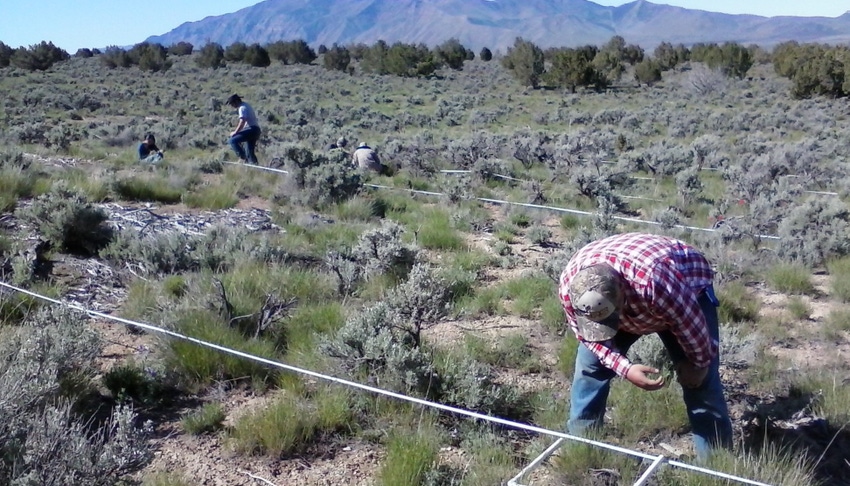May 17, 2022

New research led by an Oregon State University scientist provides the first long-term study of methods to control the spread of wildfire in the sagebrush steppe ecosystem that dominates parts of the western United States.
In recent years, the number, size and intensity of wildfires in the sagebrush ecosystem – which spans much of Nevada, Oregon and Utah, and portions of California, Idaho, Washington and Wyoming – have significantly increased primarily due to climate change and the spread of invasive grasses.
Researchers studied several methods for decreasing fire intensity. They found application of herbicides had few long-term benefits; prescribed fire reduced the fire behavior metrics they tracked but led to more invasive grasses; and mechanical thinning reduced most fire behavior metrics without increasing invasive grasses as significantly.
Related: Little carbon from living trees during wildfires
“It’s a pretty spectacular ecosystem, but it’s incredibly fragile,” said Lisa Ellsworth, lead author of the study and a range ecologist in Oregon State’s College of Agricultural Sciences. “It was named as one of the most endangered ecosystems in North America because it is so fragile and is so impacted by climate change and by invasive species and by changing fire regimes.”
Ellsworth and scientists and managers from the federal Bureau of Land Management, U.S. Forest Service, U.S. Department of Agriculture, U.S. Geological Survey, University of Idaho and Utah State University collaborated on a 10-year study of different methods to control fire in the ecosystem. Their findings were published today in the journal Ecosphere.
Publication of the research coincides with an effort by the Bureau of Land Management to construct and maintain fuel breaks along 435 miles of roads in sagebrush habitat in southeast Oregon, southwest Idaho and northern Nevada. The project is expected to take 10 to 15 years to complete.
'The pressure of time'
Ellsworth hopes the research can help inform the Bureau of Land Management project.
“I feel the pressure of time in these systems,” she said. “We need to be implementing strategies that preserve our good condition sagebrush steppe areas and get ahead of this invasive grass and fire feedback cycle that we’re in.”
The research aims to address a gap in knowledge about the long-term effects of using different methods to reduce fire-induced losses in sagebrush ecosystems.
Historically, wildfire was estimated to occur every 50 to 100 years in this ecosystem because native plants grow slowly and are spread out, which limits the ability of fire to quickly spread. That historical cycle has been substantially disrupted due to the rise of invasive annual grasses, which cover more of the landscape and dry out more quickly than native grasses, facilitating the ignition and spread of more fire. This has resulted in fire frequencies that more than double historical averages.
Related: Team probes heat, drought stress on forests
The just-published study focused on fuel treatments, activities that reduce or redistribute burnable material with the ultimate goal of decreasing fire intensity. The researchers studied three fuel treatments: herbicide application, prescribed fire and mechanical thinning, or mowing, which involves removing the top growth of sagebrush and other shrubs.
They then used a fire modeling program to test how the different treatments impacted fire behavior. They studied three fire behavior metrics: rate of spread, flame length and reaction intensity, a measure of the amount of heat per unit area of fire.
The study included six sites, ranging in size from about 50 acres to 200 acres, in five states: Oregon, Washington, Idaho, Nevada and Utah. They are all part of the Sagebrush Steppe Treatment Evaluation Project (SageSTEP), which started in 2005 to evaluate methods to restore the ecosystem in the Great Basin.
Study findings
Among their findings:
Prescribed fire resulted in the greatest reduction of the three fire behavior metrics, as this treatment was the only one to remove a large portion of the total fuel load from the sites. However, research by Ellsworth and others has found that after prescribed fire, invasive grasses often quickly establish in burned sites.
Mechanical thinning reduced flame length, an important metric because it can mean easier access for firefighters. Surprisingly, the researchers found the method was nearly as effective as prescribed fire at reducing reaction intensity and rate of spread. However, the reduction in modeled fire spread and reaction intensity lessened in year three onward, whereas reduced modeled flame lengths were maintained the entire 10 years. Ellsworth called the mechanical method a “pretty solid trade off” for reducing most fire behavior metrics and not increasing invasive grasses, like prescribed fire often does.
Herbicide treatments were ineffective at reducing fuels and or fire behavior metrics, the researchers concluded. Tebuthiuron, a herbicide that targeted broad-leaved shrubs, had no initial effects in the first two years and a minor effect after that. Dead shrubs remained standing through the 10 years, so fuel structure was not significantly altered. Imazapic, a herbicide intended to reduce annual grasses, only had a short term (two to three years) effect on reducing fuels for fire and thus only a slight reduction on modeled fire spread.
Co-authors of the paper were: Claire Williams, Oregon State’s Department of Fisheries, Wildlife, and Conservation Sciences; Beth Newingham, Agricultural Research Service; Scott Shaff and David Pyke, U.S Geological Survey; Eva Strand, University of Idaho; Matt Reeves and Jeanne Chambers, U.S. Forest Service Rocky Mountain Research Station; and Eugene Schupp, Utah State University.
The research is part of the Sagebrush Steppe Treatment Evaluation Project, funded by the U.S. Joint Fire Science Program, the National Interagency Fire Center and the Bureau of Land Management.
Source: Oregon State University, which is solely responsible for the information provided and is wholly owned by the source. Informa Business Media and all its subsidiaries are not responsible for any of the content contained in this information asset.
About the Author(s)
You May Also Like




